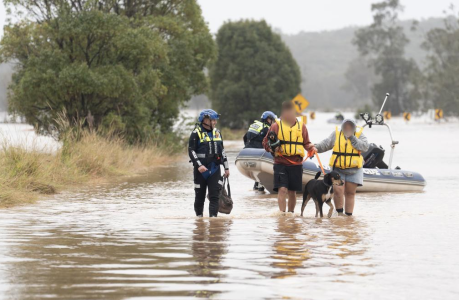Lives lost in floods as wild weather continues to isolate thousands and damages homes
By
- Replies 5
As wild weather continues to batter some regions, the devastating toll of the floods has now reached four confirmed deaths, with thousands more residents facing isolation, property damage, and uncertainty about what comes next.
For many of us who have lived through Australia’s unpredictable climate, these scenes are all too familiar—but that doesn’t make them any less heartbreaking.
The most recent tragedy unfolded near Nana Glen, about 30km northwest of Coffs Harbour, where the body of a man believed to be in his 70s was discovered inside a vehicle that had veered off Orara Way.
The car was spotted by a passing motorist in the early hours of Friday morning, and while formal identification is still pending, the loss is a stark reminder of the dangers posed by floodwaters.
This latest fatality follows the deaths of three others: Moto farmer David Knowles, 63, whose body was found on his veranda northeast of Taree; a man in his 30s who perished near Rosewood, west of Wauchope; and a woman in her 60s whose car became trapped in floodwaters near Brooklana, despite warnings from a police officer not to proceed.
Shortly, a fourth victim, an elderly man believed to be in his 70s, was also found inside his vehicle that had run off Orara Way in Nana Glen, about 30 kilometres northwest of Coffs Harbour.
His body was discovered early Friday morning after a passing motorist spotted the car. The man is yet to be formally identified.
With nearly 50,000 people cut off by floodwaters and more than 9,000 homes under threat, the scale of this disaster is immense.
The NSW State Emergency Service (SES) has responded to over 1,500 incidents in just a few days, rescuing 177 people overnight and a staggering 678 since the wild weather began.
Some areas are expected to receive up to 100mm of rain in just six hours.
The Blue Mountains and Illawarra ranges have already seen 150mm in 24 hours, and Sydney is bracing for another deluge.
While the rain is expected to ease in the Mid-North Coast and Hunter regions by Friday afternoon, BOM experts warn that the risk is far from over.
Floodwaters can continue to rise even after the rain stops, as water from upstream goes downstream.
Prominent flood warnings remain in place for the Nambucca, Macleay, Hastings, Manning, and Paterson Rivers, as well as Wollombi Brook.
Flooding and landslides have forced the closure of major roads and highways, including the Pacific Highway between Coopernook and Purfleet, the Oxley Highway at several points, and the Waterfall Way between Bellingen and Raleigh.
In Greater Sydney, Richmond and Windsor have recorded over 180mm of rain, leading to local road closures.
The chaos isn’t limited to roads—over 4,000 homes and businesses are without power across the state, and train services have been cancelled between Morisset and Newcastle Interchange and on the entire Hunter line.
Limited replacement buses are running, but authorities are urging people to delay travel if possible.
WaterNSW has warned that Warragamba Dam, which supplies much of Sydney’s water, is at 96 per cent capacity and could begin spilling as early as Friday afternoon.
While no evacuation orders have been issued for the Hawkesbury region yet, Premier Chris Minns cautioned that conditions could change rapidly, especially as floodwaters from other river systems contribute to the risk.
Prime Minister Anthony Albanese has pledged support for flood-affected residents, with funding available from Monday afternoon via the MyGov website.
Evacuation centres and additional support are being coordinated through Services Australia, and the SES has more than 2,200 volunteers on the ground, backed by 500 boats and nine helicopters.
If you or someone you know is affected, don’t hesitate to reach out for help.
The SES and local authorities are working around the clock, but your safety is paramount—never attempt to drive through floodwaters, and be cautious of hidden dangers like debris, snakes, and electrical hazards when returning to your property.
For many older Australians, the increasing frequency and severity of floods is a worrying trend.
While Australia has always been a land of droughts and flooding rains, experts point to climate change as a factor in the intensification of weather events.
Urban development, changes in land use, and aging infrastructure can also contribute to the impact of floods.
To stay safe and prepared, it's important to stay informed by keeping up to date with the latest warnings from the Bureau of Meteorology and local authorities.
Make sure you have an emergency plan in place, including knowledge of evacuation routes and a ready-to-go kit with essentials such as medications, important documents, and supplies for pets.
We remember and honour the four lives lost in the devastating floods across the NSW Mid North Coast and Hunter regions.
David Knowles, the man near Rosewood, the woman from Brooklana, and the elderly man found in Nana Glen—each taken too soon by the relentless force of nature.
Their stories have touched us deeply, and their absence leaves a lasting sorrow in the hearts of loved ones and communities alike.
May they rest in peace. As we continue to face the challenges of this disaster, let their memories remind us of the importance of care, caution, and compassion.
In mourning, we also stand together—united in grief, resilience, and the hope of safer days ahead.
 Have you or your loved ones been affected by the recent floods? Do you have memories of past flood events or tips for staying safe and prepared? Share your stories and advice in the comments below.
Have you or your loved ones been affected by the recent floods? Do you have memories of past flood events or tips for staying safe and prepared? Share your stories and advice in the comments below.
For many of us who have lived through Australia’s unpredictable climate, these scenes are all too familiar—but that doesn’t make them any less heartbreaking.
The most recent tragedy unfolded near Nana Glen, about 30km northwest of Coffs Harbour, where the body of a man believed to be in his 70s was discovered inside a vehicle that had veered off Orara Way.
The car was spotted by a passing motorist in the early hours of Friday morning, and while formal identification is still pending, the loss is a stark reminder of the dangers posed by floodwaters.
This latest fatality follows the deaths of three others: Moto farmer David Knowles, 63, whose body was found on his veranda northeast of Taree; a man in his 30s who perished near Rosewood, west of Wauchope; and a woman in her 60s whose car became trapped in floodwaters near Brooklana, despite warnings from a police officer not to proceed.
Shortly, a fourth victim, an elderly man believed to be in his 70s, was also found inside his vehicle that had run off Orara Way in Nana Glen, about 30 kilometres northwest of Coffs Harbour.
His body was discovered early Friday morning after a passing motorist spotted the car. The man is yet to be formally identified.
With nearly 50,000 people cut off by floodwaters and more than 9,000 homes under threat, the scale of this disaster is immense.
The NSW State Emergency Service (SES) has responded to over 1,500 incidents in just a few days, rescuing 177 people overnight and a staggering 678 since the wild weather began.
The Bureau of Meteorology (BOM) has issued severe weather warnings stretching from the Illawarra to the Snowy Mountains. Some areas are expected to receive up to 100mm of rain in just six hours.
The Blue Mountains and Illawarra ranges have already seen 150mm in 24 hours, and Sydney is bracing for another deluge.
While the rain is expected to ease in the Mid-North Coast and Hunter regions by Friday afternoon, BOM experts warn that the risk is far from over.
Floodwaters can continue to rise even after the rain stops, as water from upstream goes downstream.
Flooding and landslides have forced the closure of major roads and highways, including the Pacific Highway between Coopernook and Purfleet, the Oxley Highway at several points, and the Waterfall Way between Bellingen and Raleigh.
In Greater Sydney, Richmond and Windsor have recorded over 180mm of rain, leading to local road closures.
The chaos isn’t limited to roads—over 4,000 homes and businesses are without power across the state, and train services have been cancelled between Morisset and Newcastle Interchange and on the entire Hunter line.
Limited replacement buses are running, but authorities are urging people to delay travel if possible.
WaterNSW has warned that Warragamba Dam, which supplies much of Sydney’s water, is at 96 per cent capacity and could begin spilling as early as Friday afternoon.
Prime Minister Anthony Albanese has pledged support for flood-affected residents, with funding available from Monday afternoon via the MyGov website.
Evacuation centres and additional support are being coordinated through Services Australia, and the SES has more than 2,200 volunteers on the ground, backed by 500 boats and nine helicopters.
If you or someone you know is affected, don’t hesitate to reach out for help.
The SES and local authorities are working around the clock, but your safety is paramount—never attempt to drive through floodwaters, and be cautious of hidden dangers like debris, snakes, and electrical hazards when returning to your property.
While Australia has always been a land of droughts and flooding rains, experts point to climate change as a factor in the intensification of weather events.
Urban development, changes in land use, and aging infrastructure can also contribute to the impact of floods.
To stay safe and prepared, it's important to stay informed by keeping up to date with the latest warnings from the Bureau of Meteorology and local authorities.
Make sure you have an emergency plan in place, including knowledge of evacuation routes and a ready-to-go kit with essentials such as medications, important documents, and supplies for pets.
We remember and honour the four lives lost in the devastating floods across the NSW Mid North Coast and Hunter regions.
David Knowles, the man near Rosewood, the woman from Brooklana, and the elderly man found in Nana Glen—each taken too soon by the relentless force of nature.
Their stories have touched us deeply, and their absence leaves a lasting sorrow in the hearts of loved ones and communities alike.
May they rest in peace. As we continue to face the challenges of this disaster, let their memories remind us of the importance of care, caution, and compassion.
In mourning, we also stand together—united in grief, resilience, and the hope of safer days ahead.
Key Takeaways
- Four people have been confirmed dead as severe flooding continues to devastate the NSW Mid North Coast and Hunter regions, cutting off nearly 50,000 residents and threatening thousands of homes.
- Torrential rain and storms have triggered more than 150 flood warnings across eastern NSW, caused widespread road and rail closures, and left thousands of homes and businesses without power.
- Emergency services, including the SES with over 2,200 volunteers, have carried out more than 600 rescues since the wild weather began, while authorities have warned of ongoing risks even as conditions begin to ease.
- Prime Minister Anthony Albanese has pledged financial support for affected communities, and evacuation centres, as well as assistance through Services Australia, are being made available for those impacted by the disaster.








